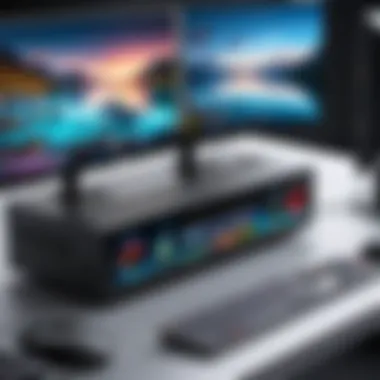Exploring Graphic Cards with Triple HDMI Ports for Enhanced Connectivity


Intro
In today's digital landscape, the graphic card is a pivotal component within personal computers and workstations. With the advent of multiple display setups gaining popularity, graphic cards that come equipped with triple HDMI ports are becoming essential tools for professionals and enthusiasts alike. Such configurations greatly enhance connectivity, allowing users to operate multiple screens simultaneously. This discussion unravels the specific features and specifications of these graphic cards, providing insights beneficial to IT specialists and tech enthusiasts.
Hardware Overview
Specifications
Graphic cards featuring triple HDMI ports are designed specifically to support advanced display technologies. Typically, these are equipped with powerful GPUs such as NVIDIA GeForce RTX or AMD Radeon RX series. The following specifications are often found:
- GPU Architecture: Modern architectures, such as NVIDIA's Ampere or AMD's RDNA 2, provide increased efficiency and performance.
- Memory: Most of these graphic cards come with 8GB or more GDDR6 memory. Higher memory allows for better handling of high resolution tasks.
- Bandwidth: High bandwidth memory is crucial as it determines how much data can be transmitted simultaneously, essential for smooth multi-display experiences.
These specifications highlight the importance of selecting a graphic card that can support the required applications efficiently.
Performance Metrics
The performance of graphic cards with triple HDMI ports can be evaluated through several benchmarks and metrics:
- Frame Rates: When running applications across three displays, the frame rate should ideally remain above 60 FPS for optimal performance.
- Rendering Time: Time taken to render high-resolution graphics is a key performance indicator. Lower rendering times contribute to productivity in tasks such as video editing and 3D modeling.
- Thermal Throttling: Effective cooling mechanisms are vital, as overheating can significantly impact performance.
Understanding these performance metrics aids users in evaluating and choosing the most suitable graphic cards for their specific needs.
Software Analysis
Features and Functionality
Many graphic cards with triple HDMI ports come with advanced software solutions to manage displays more effectively. Features such as multiple display support, resolution settings, and adjustments in refresh rates are crucial.
- NVIDIA Control Panel: This software allows users to fine-tune settings, customize display configurations, and monitor performance metrics.
- AMD Radeon Software Adrenalin: Similar to its NVIDIA counterpart, this software provides tools for optimizing games and applications.
User Interface and Experience
The graphic card's user interface appears straightforward, yet it is critical for enhancing user experience. Intuitive design aids in quickly navigating through settings. A responsive interface contributes to a seamless interaction when configuring multiple displays, thereby improving productivity.
"A graphic card with a well-integrated user interface can save time and reduce frustration during setup."
As users become familiar with advanced configurations, they unlock the potential of their hardware.
Ending
Graphic cards with triple HDMI ports are at the forefront of today’s technological demand, allowing more efficient workflows and expansively enhancing connectivity options. Their specifications and performance metrics are indicative of their capabilities. As the landscape of graphics technology continues to evolve, these graphic cards not only meet current demands but also pave the way for future applications.
Foreword to Graphic Cards
Graphic cards are essential components in computer systems, particularly for those engaging in tasks that require high-performance visuals. Their importance grows with the increasing demand for robust graphical capabilities in fields such as gaming, design, and data analysis. In this article, we will delve into the realm of graphic cards, particularly focusing on models that feature three HDMI ports. This unique configuration offers significant advantages for connectivity, allowing multiple displays to be managed seamlessly.
Definition and Purpose
A graphic card, or GPU, primarily serves to render images, animations, and videos. This specialized hardware takes the load off the CPU, enabling smoother performance, particularly for graphics-intensive tasks. The GPU processes complex mathematical operations related to rendering and provides output to displays through various ports.
In today’s multi-decade world of technology, having a capable graphic card is no longer just a luxury—it's often a necessity. Users require the ability to connect several displays, whether for extended workspaces or immersive gaming experiences. Furthermore, as high-definition content becomes ubiquitous, the role of graphic cards has evolved, highlighting the need for efficiency and reliability.
Evolution of Graphic Cards
The journey of graphic cards has witnessed remarkable advancements since their inception. Early graphic cards were simplistic, designed merely to output basic visuals. Over the years, the industry has experienced a transformation driven by innovations in technology and user demands.


In the 1990s, the introduction of 3D graphics initiated a new era for GPUs. Companies like Nvidia and ATI began to dominate the market, producing cards that could handle more complex textures and geometries. The advent of DirectX and OpenGL also facilitated better graphic handling, leading to richer multimedia experiences.
As we moved into the 2000s and beyond, GPUs became more integrated within systems, including functionalities aimed at improving performance in gaming and rendering applications. The development of multi-GPU setups introduced opportunities for enhanced performance as well as higher resolutions.
Presently, the focus has shifted towards optimizing performance across multiple displays. The existence of models with triple HDMI ports exemplifies how evolution is shaped by user needs. Enabling three concurrent connections allows for better multitasking, enriching overall productivity and user experience. This trend supports the requirements of IT professionals and creative workers who benefit from an extensive visual workspace without significant quality compromise.
Significance of HDMI Ports
In today's digital landscape, the demand for versatile connectivity options in graphic cards has surged. This is where HDMI ports come into play, serving as vital conduits for transmitting high-definition video and audio signals. Their significance is not merely in the convenience of connectivity, but also in their ability to support various resolutions and refresh rates. HDMI ports can cater to a wide range of devices, making them crucial for any graphics-heavy application, whether for gaming, productivity, or media consumption.
HDMI Standards Explained
HDMI technology has evolved through various standards, each providing incremental improvements in performance and capabilities. Currently, prominent standards include HDMI 2.0 and HDMI 2.1. HDMI 2.0 supports 4K resolution at 60Hz, offering players and professionals the clarity they need for an enhanced experience. Conversely, HDMI 2.1 represents a giant leap forward, capable of handling 8K at 60Hz and 4K at 120Hz. Additionally, HDMI 2.1 introduces features such as Variable Refresh Rate (VRR) and Quick Frame Transport (QFT), enhancing the user experience significantly in gaming and high-performance scenarios.
"The evolution of HDMI standards demonstrates a continuous drive towards higher resolutions and frame rates, catering to the increasing demands of users across various sectors."
Benefits of Multiple HDMI Ports
The inclusion of multiple HDMI ports on graphic cards fundamentally transforms how users interact with their systems. Here are some key benefits:
- Increased Connectivity: Having three HDMI ports allows for simultaneous connection to multiple displays. This is invaluable for professionals who require extended desktop setups to increase productivity or gamers seeking immersive multi-screen gaming experiences.
- Flexibility with Devices: Users can connect different types of devices, including monitors, TVs, projectors, and VR headsets without needing to swap cables frequently. This reduces downtime and maximizes productivity.
- Enhanced Resolution Support: Multiple ports can manage both high-definition and ultra-high-definition content from various sources. This capability ensures that users can enjoy seamless transitions between content without sacrificing quality.
In essence, the significance of HDMI ports in graphic cards cannot be overstated. They enable a more dynamic interaction with technology, adapting to the evolving landscape of user needs and preferences.
Understanding Triple HDMI Configurations
Triple HDMI configurations are becoming increasingly relevant in the realm of graphic cards, particularly as technology evolves. A setup with three HDMI ports on a graphics card offers substantial flexibility for users. This is especially true for IT professionals and tech enthusiasts who rely on multiple displays for enhanced productivity and immersive experiences. The structure of a triple HDMI configuration can allow for astonishing usage scenarios that were once limited.
Technical Specifications
When assessing graphics cards with three HDMI ports, it is paramount to consider their technical specifications. The real potential of such configurations rests on the card's capacity to handle various resolutions and refresh rates efficiently. Most modern graphic cards equipped with triple HDMI ports support 4K resolutions at standard refresh rates. Some can even facilitate 120Hz output, a critical feature for gaming applications or high-frequency trading.
Additionally, the bandwidth capability of each HDMI port is important. Standard HDMI 2.0 can convey data rates up to 18 Gbps per channel, while the newer HDMI 2.1 can offer 48 Gbps. Compatibility with these specifications will determine how fluidly the connected monitors perform, especially when running resource-intensive applications.
Key Specifications to Consider:
- HDMI Versions: 2.0 vs 2.1
- Resolutions Supported: Up to 4K or higher
- Refresh Rates: 60Hz, 120Hz, etc.
- Bandwidth: Critical for multi-monitor setups
Types of Use Cases
The versatility offered by triple HDMI setups opens the door to various practical applications. Here are several notable use cases:
- Multi-Monitor Setups for Productivity: Many professionals rely on multiple monitors to manage workloads effectively. A triple HDMI configuration allows for seamless display management. Users can spread projects across three screens, improving visibility and efficiency.
- Gaming and High-Performance Applications: Gamers benefit immensely from multiple HDMI ports. They can connect different screens for various purposes: gaming on one, communication on another, and media streaming on yet another. This enables complex setups that enhance the overall gaming experience.
- Professional Creative Workflows: Content creators often require robust setups that involve various software being displayed simultaneously. With triple HDMI ports, graphic designers and video editors can utilize multiple displays to monitor timelines, tool palettes, and preview windows. This ultimately speeds up their workflows.
Market Analysis of Graphic Cards with Three HDMI Ports
In discussing graphic cards with three HDMI ports, a market analysis helps illuminate critical trends and factors influencing consumer choices. The presence of three HDMI outputs opens pathways for enhanced connectivity options, making these cards appealing to both enthusiasts and professionals alike. Understanding the current market dynamics, including popular models and their pricing strategies, can guide potential buyers in making an informed decision.
Current Leading Models
As of 2023, several graphic card models stand out for their three HDMI port configurations. These models have garnered attention for their performance and usability in various scenarios.
- NVIDIA GeForce RTX 3080: This card not only features triple HDMI support but also excels in rendering high-quality graphics. It is particularly favored by gamers and content creators.
- AMD Radeon RX 6800 XT: Known for competitive pricing and robust performance, this model is effective for multi-display setups, making it a strong contender.
In addition to these, brands like ASUS and MSI have introduced their custom models, often enhancing cooling systems or increasing clock speeds, providing unique selling propositions to attract buyers.


Price Comparison and Value Assessment
Examining the price range of graphics cards with triple HDMI ports reveals a significant variation. Prices typically range from around $500 to $1,200 depending on specifications and brand.
- Entry-Level Options: Cards like the NVIDIA GeForce GTX 1660 Super, which may offer three HDMI ports, can be found at lower price points, catering to budget-conscious users.
- Mid-Range Choices: The AMD Radeon RX 6700 XT serves as a middle ground for users who require solid performance without breaking the bank.
- High-End Models: The premium graphic cards, such as the NVIDIA RTX 3090, offer unmatched performance but come with a hefty price tag.
Performance Considerations
Performance considerations are essential for those looking at graphic cards with triple HDMI ports, as they directly impact how effectively a card can deliver visual content. Understanding these factors helps users select the right card for their specific use cases, whether for gaming, creative work, or productivity.
Impact on Graphics Performance
Graphics performance is primarily influenced by the GPU's architecture, memory bandwidth, and processing capabilities. When a card features three HDMI ports, it allows for flexible display configurations that can enhance the overall experience. For high-resolution displays or high refresh rates, it is crucial to select a card that can handle multiple outputs without compromising performance.
- Resolution and Refresh Rate: Achieving optimal graphics performance depends on how well the card manages high resolutions, such as 4K, across several monitors.
- Frame Rates: A high frame rate is essential for gaming and smooth operation in professional environments. The ability to connect three displays may demand more from the GPU, so users must be aware of thermal and power limits.
- Multi-Display Workflows: For multitasking professionals, a graphic card's performance capacity enables a coherent workspace setup, leading to better productivity.
In summary, the impact on graphics performance is significant when using triple HDMI ports because the demands on processing power and memory can escalate quickly as the number of displays increases.
Thermal Management
Thermal management becomes a critical point when discussing graphic cards with multiple HDMI ports. The increased workload from powering several displays can lead to elevated temperatures within the card being utilized. Proper management ensures longevity and stable performance.
Key aspects of effective thermal management include:
- Cooling Solutions: Various graphics cards incorporate different cooling mechanisms such as air cooling, liquid cooling, or hybrid designs to manage heat dissipation. A robust cooling solution is essential, especially for high-performance cards designed to run multiple displays.
- Temperature Monitoring: It is advisable to keep an eye on thermal metrics using software tools. High temperatures can lead to throttling, where performance is reduced to avoid overheating.
- Case Ventilation: Good airflow in the computer case is necessary as it aids in heat expulsion. Ensuring that there are enough fans or optimally positioned vents will contribute to the efficiency of thermal management.
Effective thermal management not only enhances performance but also prevents hardware failures, making it a key consideration for those investing in graphic cards with triple HDMI outputs.
Compatibility and Installation
Understanding compatibility and installation is vital when choosing graphic cards with triple HDMI ports. The integration of multiple ports can enhance connectivity possibilities but requires thoughtful consideration of existing systems.
System Requirements
A graphic card that includes three HDMI ports must align with the specific requirements of your computer setup. Key factors to inspect include:
- Motherboard Compatibility: Ensure your motherboard has the correct PCIe slot available. It should be compatible with the card's dimensions.
- Power Supply: Check that your power supply unit can support the new graphic card. Look for the recommended wattage and any specific power connectors required.
- Cooling Solutions: With the additional ports and typically better performance, consider if your cooling system can manage the heat output. Some cards may run hotter and demand better airflow.
- Operating System: Verify that your operating system supports the drivers for the card. Most brands offer good support for major systems like Windows or Linux, but it’s essential to confirm.
Installation Tips and Best Practices
When it comes to installing a graphic card with multiple HDMI ports, following systematic steps can prevent potential issues:
- Preparation: Before installation, ensure you have the necessary tools, including a screwdriver and an anti-static wrist strap.
- Remove the Old Card: If you are replacing an existing graphic card, carefully uninstall it. This process typically involves unscrewing and gently pulling the card from the slot.
- Insert the New Card: Align the new graphic card's PCIe connector with the motherboard slot. Apply even pressure to ensure it is seated correctly.
- Secure the Card: Once inserted, fasten it with screws to the case. This secures the card and avoids unwanted movement.
- Connect Power Cables: If the card requires additional power, secure the necessary power cables to it.
- Install Drivers: Boot the computer and install the latest drivers for the graphic card to ensure optimal performance and utilization of the HDMI ports.
- Test Functionality: Finally, connect monitors or devices to the HDMI ports to confirm that they are functioning correctly. Adjust display settings as needed.
Keeping the installation area static-free enhances safety for your new graphic card.
These steps emphasize a systematic, precautionary approach for anyone planning to add or replace a graphic card in their system. Following these guidelines ensures a successful installation and optimal performance of the graphic card, particularly for those leveraging multiple HDMI ports for diverse applications.
Use Cases for Three HDMI Ports
The advent of graphic cards equipped with triple HDMI ports has opened new avenues for utilization in various settings. These cards cater primarily to those who demand high performance from their systems, without compromising on versatility. Understanding the specific use cases for three HDMI ports is crucial, as it allows users to maximize their investment, boosting both productivity and entertainment. Whether for multi-monitor setups, gaming experiences, or professional workflows, the effective application of these ports can lead to enhanced productivity and better overall performance.
Multi-Monitor Setups for Productivity
Multi-monitor setups have become increasingly popular in the professional sphere. With three HDMI ports available, users can seamlessly connect multiple displays. This capability is not just about having more screens; it is about the efficiency and workflow enhancement that comes with them. Tasks such as data analysis, coding, or video editing can be executed with greater ease when users can spread their applications across multiple displays.


For instance, a financial analyst can have their main dashboard on one screen and supplementary charts or data sets on the others. This eliminates the constant switching between tabs and applications, saving time and effort. Furthermore, multi-monitor setups can help in organizing various projects simultaneously. The clarity and visibility offered by additional screen real estate can significantly improve focus and reduce errors.
Gaming and High-Performance Applications
Gamers have a unique relationship with technology, often pushing hardware to its limits. Triple HDMI ports in graphic cards cater directly to their needs. Having three outputs allows gamers to set up immersive gaming environments, using multiple monitors to create expansive visual experiences. This can take the form of two monitors for gameplay, while the third can display a stream or social media feeds, enhancing interactivity.
Moreover, many modern games support multi-monitor configurations natively. This enhances the field of view, providing a competitive advantage in various genres, especially first-person shooters. High-performance applications also benefit from the enhanced connectivity of three HDMI ports, allowing users to run demanding software seamlessly across different screens.
Professional Creative Workflows
In the realm of creative professionals, graphics workstations often require robust configurations. Triple HDMI ports can be invaluable for graphic designers, video producers, and photographers. For example, a designer can use one monitor for their design application, another to view reference material, and the third for communication tools such as email or chat. This setup fosters a smoother workflow, minimizing distractions and maximizing focus on the project at hand.
Additionally, in video editing, where color grading and real-time previews are crucial, having multiple outputs allows editors to better view their project from different angles. Being able to compare multiple iterations or see raw footage alongside edited versions bumps up efficiency. Given the creativity often demanded in professional environments, the right tool—like a graphic card with triple HDMI outputs—can significantly impact the quality of work produced.
"Utilizing multiple monitors not only streamlines workflows but also enhances creativity and response time across tasks."
With the proper understanding of these use cases, tech enthusiasts and IT professionals can leverage the potential of graphic cards with triple HDMI ports. This knowledge allows for tailored solutions that fit their specific scenarios, boosting overall output in both personal and professional settings.
Future Trends in Graphics Technology
The landscape of graphics technology is continuously evolving. Understanding future trends is crucial for IT professionals and tech enthusiasts alike. Emerging technologies and evolving standards in this field greatly impact how graphic cards function, particularly those equipped with triple HDMI ports. These changes promise enhancements in performance, compatibility, and user experience, which are essential for multi-display setups and complex workflows.
Emerging Technologies
Graphical processing units (GPUs) are experiencing rapid advancements. Innovations such as artificial intelligence and machine learning integration are becoming commonplace within graphic cards. These technologies enable more efficient processing, improving rendering times and enhancing visual fidelity.
Additionally, ray tracing technology is gaining traction. This allows for more realistic lighting and shadows in games and simulations. With the advent of real-time ray tracing, users benefit from immersive graphics that were once only possible in pre-rendered scenarios. Companies like NVIDIA and AMD are at the forefront of these developments, releasing GPUs that support such capabilities.
Benefits of these technologies include:
- Enhanced visual quality, leading to more immersive experiences.
- Reduced workload on the CPU, as GPUs can take on more processing tasks.
- Increased efficiency in graphical tasks, allowing for smoother performance in gaming and professional applications.
These trends indicate that future graphic cards, especially those with multiple HDMI outputs, will cater to both high-end gaming and professional creative domains.
Impact of Evolving Standards
Conforming to new industry standards is essential for graphic cards. HDMI standards continue to evolve, with HDMI 2.1 being a recent development. This standard increases bandwidth, supports higher resolutions, and enhances refresh rates. As resolutions move toward 8K and beyond, the ability of graphic cards to manage these outputs becomes increasingly critical.
Also, evolving standards encourage manufacturers to implement better compatibility across devices. This opens up opportunities for graphic cards to not just serve as display interfaces but also as central hubs for various devices.
"The ability to connect multiple displays effeciently shapes the future of workspaces and gaming environments, making it essential for graphic card developers to adapt swiftly to changing standards."
In summary, the role of graphic cards, especially those equipped with multiple HDMI ports, is becoming increasingly versatile. Keeping abreast of these trends enables users to make informed decisions about their hardware needs, while also preparing for future developments in the graphics technology realm. As new technologies emerge and standards evolve, the path forward for graphic cards will likely be marked by greater integration, efficiency, and performance.
Ending
The conclusion of this article serves to reinforce the significance of graphic cards equipped with triple HDMI ports. In an era marked by multifaceted visual needs, the importance of these ports cannot be overstated. The ability to connect multiple displays simultaneously is a game-changer for users seeking productivity, immersive gaming experiences, or sophisticated creative workflows.
Recap of Key Insights
The discussions throughout this article highlighted several critical insights:
- Versatility: Triple HDMI ports enhance versatility, allowing for expanded workspace and improved multitasking.
- Performance: Selected models offer significant gains in graphics performance, making them pivotal in gaming and professional applications.
- Compatibility: Most modern graphic cards with these configurations are compatible with various systems, promoting broader usage.
- Emerging Trends: Technologies like DisplayPort and HDMI 2.1 demonstrate the evolutionary nature of graphic card connectivity, which will continue to influence future designs.
Final Thoughts on Selecting a Graphic Card
When selecting a graphic card, consider factors beyond just the number of HDMI ports. Assess the overall performance, thermal management capabilities, and the specific needs of your computing environment. Brands like NVIDIA and AMD lead the market with innovative solutions that prioritize both functionality and performance.
Adopting a graphic card with triple HDMI ports opens doors to maximize productivity and engagement with digital content. Therefore, thorough research and consideration should guide your decision-making process, ensuring you invest in a component that aligns with your technological requirements and future-proofing strategies.
"In a world that increasingly relies on visual information, the right graphic card can make all the difference."
This advanced connectivity option is more than a feature; it is an enabler, transforming how tech enthusiasts and professionals engage with their digital workspace.



